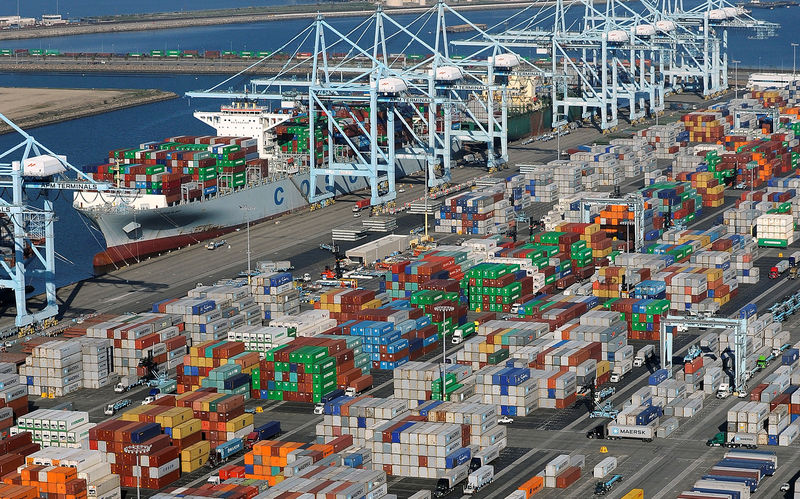By Lucia Mutikani
WASHINGTON (Reuters) - New orders for key U.S.-made capital goods surged in June, suggesting some improvement in business investment, but economic growth is still expected to have slowed sharply in the second quarter amid weaker exports and a smaller inventory build.
Still, the longest U.S. economic expansion on record remains supported by a strong labor market. Other data on Thursday showed the number of Americans filing claims for unemployment benefits dropped to a three-month low last week.
The economy has been hurt by the U.S.-China trade war and slowing growth overseas. These factors are expected to encourage the Federal Reserve to cut interest rates next Wednesday for the first time in a decade.
The Commerce Department said orders for non-defense capital goods excluding aircraft, a closely watched proxy for business spending plans, jumped 1.9% last month after rising 0.3% in May.
Orders for these so-called core capital goods in June increased across the board, with demand for machinery rising by the most in nearly 1-1/2 years. Economists polled by Reuters had forecast core capital goods orders would gain 0.2% in June.
"The stronger-than-expected orders are a positive sign that business investment and manufacturing sector activity have not weakened substantially further following softness earlier in the year," said Veronica Clark, an economist at Citi in New York.
Core capital goods orders rose 1.9% on a year-on-year basis. Core capital goods shipments, which are used to calculate equipment spending in the government's gross domestic product measurement, increased 0.6% in June after advancing 0.5% in the prior month.
The third straight monthly increase in core capital goods orders did little to change expectations that business spending on equipment contracted in the second quarter after falling in the January-March period for the first time in three years.
The government will publish its snapshot of second-quarter GDP on Friday. According to a Reuters survey of economists, GDP likely increased at a 1.8% annualized rate in the April-June quarter, moderating from the first quarter's brisk 3.1% pace.
The dollar slipped against a basket of currencies after European Central Bank President Mario Draghi signaled another round of monetary easing but expressed caution about pulling the trigger too quickly. U.S. Treasury prices fell. Stocks on Wall Street were trading lower.
'SLOWED NOTABLY'
Business investment and housing have been flagged by the Fed as areas of weakness in the economy.
Fed Chairman Jerome Powell early this month described business investment as appearing to have "slowed notably," saying this might "reflect concerns about trade tensions and slower growth in the global economy."
June's surge in core capital goods orders suggests a pickup in business spending on equipment, but economists cautioned that the strength could be short-lived given an inventory glut in the motor vehicles industry and design problems at Boeing (NYSE:BA) that are helping to undercut the manufacturing sector.
Manufacturing accounts for about 12% of the economy. The sector's woes were highlighted by Caterpillar (NYSE:CAT), which on Wednesday reported earnings below Wall Street's estimates and said its full-year profits were expected to be at the lower end of its earlier forecast.
Boeing also reported its biggest-ever quarterly loss on Wednesday due to the spiraling cost of resolving issues with its 737 MAX and warned it might have to shut production of the grounded jet completely if it runs into new hurdles with global regulators to getting its best-selling aircraft back in the air.
The single-aisle plane was grounded worldwide in March after two fatal crashes in Ethiopia and Indonesia. Production of the aircraft has been reduced and deliveries suspended.
Overall orders for durable goods, items ranging from toasters to aircraft that are meant to last three years or more, increased 2.0% in June, the most since August 2018, after declining 2.3% in the prior month. Unfilled orders fell for a second straight month.
"Nevertheless, with the incoming global data still deteriorating and domestic capacity utilization falling, we still expect overall business investment to remain weak in the second half of the year," said Michael Pearce, a senior U.S. economist at Capital Economics in New York.
In a second report on Thursday, the Commerce Department said the goods trade deficit fell 1.2% to $74.2 billion in June, with imports dropping $4.6 billion to $210.5 billion. Imports fell broadly last month, potentially hinting at some cooling in domestic demand after gaining speed in recent months.
Goods exports fell $3.7 billion to $136.3 billion last month. The decline was across the board, with exports of consumer goods tumbling 10.9%, the largest drop since 1989.
Despite the smaller trade deficit in June, trade was probably a drag on GDP growth in the second quarter. Falling imports and exports also suggest the White House's "America First" policies are hampering trade flows, which economists say are hurting the global economy.

The Commerce Department also said wholesale inventories rose 0.2% after increasing 0.4% in May. Stocks at retailers fell 0.1% last month following a 0.3% rise in May. The slowdown in inventory growth reflects an acceleration in consumer spending in the second quarter.